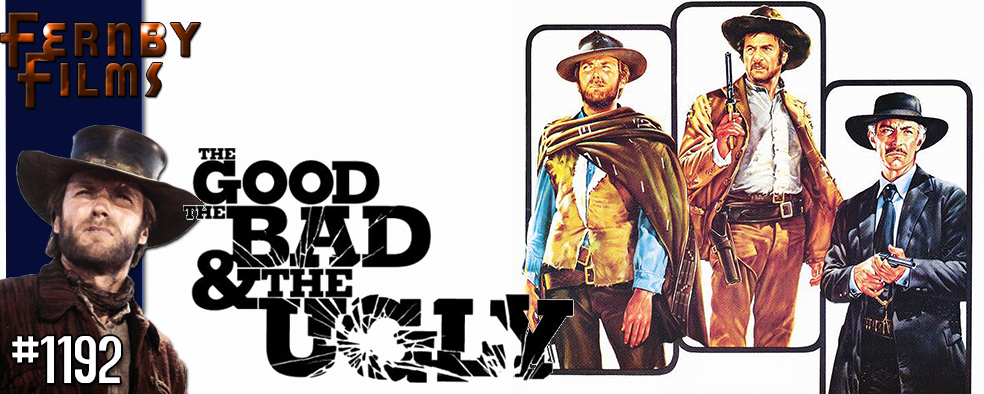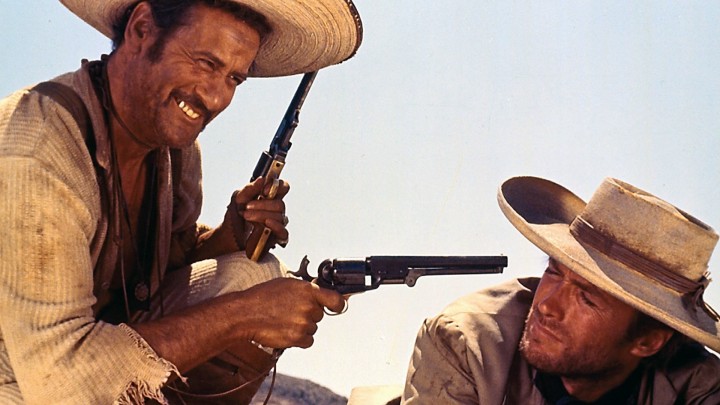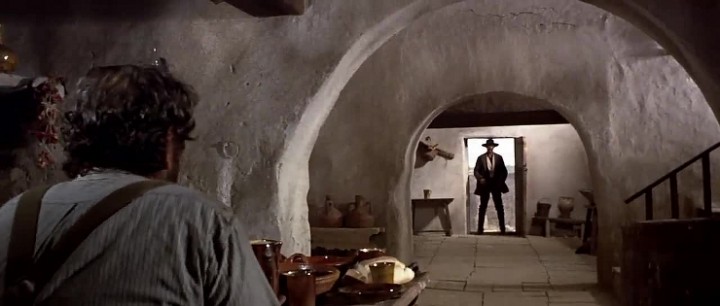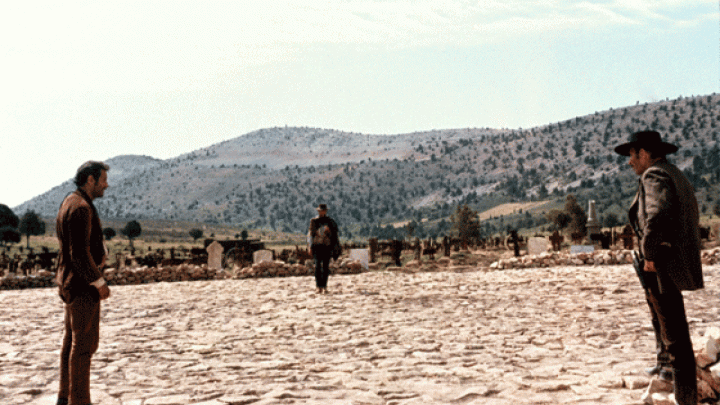Movie Review – Good The Bad And The Ugly, The

Director : Sergio Leone
Year Of Release : 1966
Principal Cast : Clint Eastwood, Lee Van Cleef, Eli Wallach, Aldo Giuffre, Mario Brega, Luigi Pistilli, Al Mulock, Antonio Casas, Cantonio Casale, Sergio Mendizabal, John Bartha, Rada Rassimov, Claudio Scarchilli, Sandro Scarchilli, Enzo Petito.
Approx Running Time : 178 Minutes
Synopsis: A bounty hunting scam joins two men in an uneasy alliance against a third in a race to find a fortune in gold buried in a remote cemetery.
*******
If there’s a better exponent of the Western, I do believe it’s yet to be made. The Good The Bad & The Ugly, Sergio Leone’s third film to star Clint Eastwood as the eponymous “Man With No Name”, and the final film in the Dollars Trilogy, is described in certain circles as a masterpiece. Although that word is attached to many, many films which patently aren’t of that high a quality, when it comes to this film, it’s as apt a descriptor as there ever has been. Leone’s mastery of the genre, his approach to filming with the wide 2.35 ratio – as I’ve mentioned in both my reviews to A Fistful Of Dollars and For A Few Dollars More – and his ability to convey character and narrative through dialogue-free sequences, punctuated only by gunfire and extreme close-up reaction shots, is in full flight here. Sure, it might not hold the dramatic weight of Eastwood’s own Academy Award-winning film Unforgiven, nor does it showcase the star-studded roster of modern classics such as Tombstone or Wyatt Earp, and it certainly isn’t the realistic grit of films such as 3:10 To Yuma, True Grit or Open Range, but as a self-described deconstruction of the Western genre, it’s a staggering achievement of visual supremacy elevating a simple story and altogether stock genre characters.
 Following the increasing success of the previous Dollars films, Leone persuaded Eastwood, together with fellow For A Few Dollars More co-star Lee Van Cleef, to return to the saddle once more, in a film destined to become not only a cultural touchstone for many, but an outright classic of cinema; as was the norm for Leone, neither actor portrayed the same character they had previously, for in this film Van Cleef was very much an anti-hero type, whilst Eastwood’s more cynical evocation of the Man With No Name resembled a less conspicuously moral character, resulting in a film filled with shades of grey moreso than characters of black and white simplicity. Van Cleef plays Angel Eyes, a hired bounty hunter and killer who reluctantly teams up with Eastwood’s “Blondie”, to track down a missing cache of stolen coins. Joining them is the great Eli Wallach, as Tuco, a Mexican bandit who also reluctantly has to team up with Angel Eyes and Blondie.
Following the increasing success of the previous Dollars films, Leone persuaded Eastwood, together with fellow For A Few Dollars More co-star Lee Van Cleef, to return to the saddle once more, in a film destined to become not only a cultural touchstone for many, but an outright classic of cinema; as was the norm for Leone, neither actor portrayed the same character they had previously, for in this film Van Cleef was very much an anti-hero type, whilst Eastwood’s more cynical evocation of the Man With No Name resembled a less conspicuously moral character, resulting in a film filled with shades of grey moreso than characters of black and white simplicity. Van Cleef plays Angel Eyes, a hired bounty hunter and killer who reluctantly teams up with Eastwood’s “Blondie”, to track down a missing cache of stolen coins. Joining them is the great Eli Wallach, as Tuco, a Mexican bandit who also reluctantly has to team up with Angel Eyes and Blondie.
Watching this film for the first time in about a dozen years, it strikes me that there’s a reason it’s so well considered in the echelon of the genre. From a technical standpoint, both visually and narratively, the film is superb; although the film features more of the poor lip-sync dubbing of the earlier films (something of a kitschy, appropriately ragged low-budget throwback that works for the film’s appeal, rather than against it) and a roster of generic foley and effects cues, Leone’s vision with the characters and the cinematography, together with his ability to define a film through its silences and pauses, as well as the great performances (especially Wallace, who looks to be having a blast here – word is it he nearly died thrice on the set during production) give the film a veneer of iconoclastic mythologising. Heroism isn’t a trait among great Western celebrities, for almost all of them have elements of unsavouriness that sour much of their popularity – and it’s this kind of character investigation which has made the genre so dour since Unforgiven set the bar again – and Leone taps into the violent, selfish motivations of people living at this time as a metaphor for the rapidly changing society of the era.
 Let’s face it: none of the leads in this film are particularly nice, but then, the West wasn’t really the place for nice people. The film haggles with its placement in Civil War backgrounding, references to the North and South and the eventual victors, as well as the birth-pangs of the newly formed United States, provide a swirling canvas of inevitable violence and cruelty. Much like the characters in the film, particularly Van Cleef’s Angel Eyes, who swaggers through the film as a cold and evil presence of vindictive masculinity, perhaps appropriating the West’s kill-or-be-killed machismo a little too eagerly. Wallach’s Tuco, who is given as having a raft of heinous crimes against his name, comes across more as a buffoonish, cartoon character, which is weird considering we learn more about him than we ever do about either Angel Eyes of Blondie. Wallach never struck me as a convincing Mexican – he still doesn’t – and even he’s dubbed into English in the movie!
Let’s face it: none of the leads in this film are particularly nice, but then, the West wasn’t really the place for nice people. The film haggles with its placement in Civil War backgrounding, references to the North and South and the eventual victors, as well as the birth-pangs of the newly formed United States, provide a swirling canvas of inevitable violence and cruelty. Much like the characters in the film, particularly Van Cleef’s Angel Eyes, who swaggers through the film as a cold and evil presence of vindictive masculinity, perhaps appropriating the West’s kill-or-be-killed machismo a little too eagerly. Wallach’s Tuco, who is given as having a raft of heinous crimes against his name, comes across more as a buffoonish, cartoon character, which is weird considering we learn more about him than we ever do about either Angel Eyes of Blondie. Wallach never struck me as a convincing Mexican – he still doesn’t – and even he’s dubbed into English in the movie!
If nothing else, The Good The Bad & The Ugly is a step up in production value from both the previous films. The sets are larger, the expansive landscape comes into play more often, and the lengthy supporting cast, most of whom appear in the film momentarily, add to the film’s tenure as a classic. It’s also here we get to hear one of the great film scores of all time, from Ennio Morricone. The yodel-hum-whistle motif the film employs is perhaps even more famous than the film it comes from, if that’s possible, thanks to its references in multiple films since as a pop-culture shorthand for “cowboy”. Actually, the entire score is superb, not just the most memorable theme, utilising a traditional orchestra, Mexican overtones and poetic, vaporous themes of isolation, loneliness and fear.
 Then there’s the film’s cinematography. Like its immediate predecessor, The Good The Bad & The Ugly is a masterclass in framing, editing and visual style. The DP on this film was the legendary Tonino Delli Colli, who would go on to work with the likes of Polanski and Fellini, and also shoot Roberto Begnini’s Life In Beautiful, and it’s fair to say his work here is stellar. From lighting, to framing and the use of shadows and shade to contrast the actions of the lead characters, the film has a rustically fantasy-esque vibrancy that encapsulates Leone’s idea of a mythological Western. Key to the film’s style is the use of the wide aspect ratio to tell the story, and again, Leone uses the entire frame, or sometimes only part of it, to continue driving either the narrative or the characters emotional arcs. The framing of fight sequences, either fists or guns, the battle sequences peppering the last half of the film, as well as wide landscape shots including the memorable cemetary-set finale, are compelling in what they show us in every moment; like a moving work of art, Leone coerces us to continually check the entire width of the frame with our eyes, using focus and vistas, as well as close-ups, ensuring we focus solely on his film and nothing else. It’s a visual style which directors would plagiarise in decades to follow.
Then there’s the film’s cinematography. Like its immediate predecessor, The Good The Bad & The Ugly is a masterclass in framing, editing and visual style. The DP on this film was the legendary Tonino Delli Colli, who would go on to work with the likes of Polanski and Fellini, and also shoot Roberto Begnini’s Life In Beautiful, and it’s fair to say his work here is stellar. From lighting, to framing and the use of shadows and shade to contrast the actions of the lead characters, the film has a rustically fantasy-esque vibrancy that encapsulates Leone’s idea of a mythological Western. Key to the film’s style is the use of the wide aspect ratio to tell the story, and again, Leone uses the entire frame, or sometimes only part of it, to continue driving either the narrative or the characters emotional arcs. The framing of fight sequences, either fists or guns, the battle sequences peppering the last half of the film, as well as wide landscape shots including the memorable cemetary-set finale, are compelling in what they show us in every moment; like a moving work of art, Leone coerces us to continually check the entire width of the frame with our eyes, using focus and vistas, as well as close-ups, ensuring we focus solely on his film and nothing else. It’s a visual style which directors would plagiarise in decades to follow.
The Good The Bad & The Ugly is a film like no other. Actually, it’s a film like many others, but the way it both encapsulates and mythologises the Western genre is game-changing. Eastwood’s iconic role notwithstanding, the film is both a visual homage and usurping benchmark setting genre classic that warrants the appellation. It not only wallows in violence, but provides some chuckles and moments of ratcheting tension carved from the landscape of Italy and Spain. As a capper for the trilogy, it’s the best of the bunch, as a stand-alone Western it’s easily a top-three of the genre, perhaps ever. The Good The Bad & The Ugly is an out-and-out masterpiece.












What a movie, this is. Best of the trilogy. Not quite the best Western, but Leone made that one, too, so it's okay (Once Upon a Time in the West). Still, I definitely think it's top 3, at least of what I've seen.
My recent post Six Things Missing From Straight Outta Compton
Ha ha, I still have to get around to reviewing OUATITW but I will one day…. Definitely a classic!
Brilliant film, absolutely the greatest Western of all time! It's amazing how Tuco is the main character / villain / comic-relief. What other movie has been able to pull off such a feat?
Very, very few films have achieved what TGTBATU did back in the day. Yet another example of Leone's mastery…